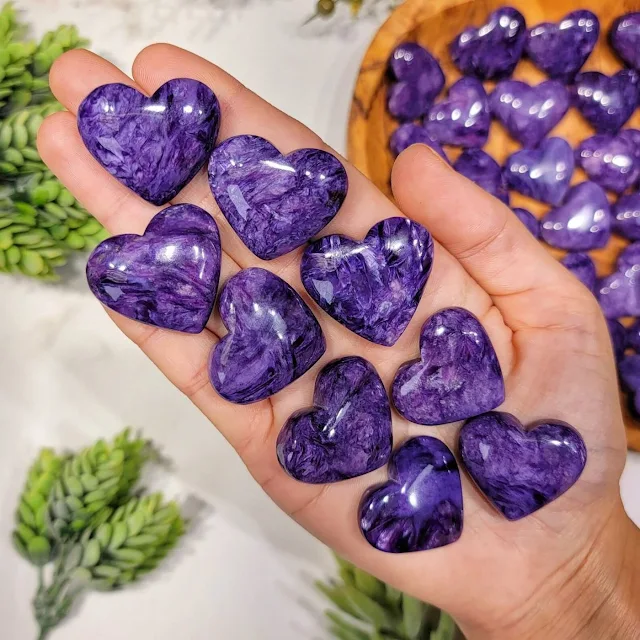Charoite: Rare Purple Gemstone
Charoite is a stunning and relatively rare silicate mineral prized for its vibrant purple hues and swirling chatoyant luster. It was first discovered in the 1940s in the Sakha Republic area of Siberia, Russia, and named after the Chara River, although the river is actually located quite far away from the discovery site. Charoite is a rare mineral, found only in Siberia.
Charoite is translucent lavender to purple in colour with a pearly lustre. Charoite is strictly massive in nature, and fractures are conchoidal. It has an unusual swirling, fibrous appearance, sometimes chatoyant, and that, along with its intense colour, can lead many to believe at first that it is synthetic or enhanced artificially.
Charoite mostly appears opaque in clarity but it may seem somewhat transparent in some cases Charoite’s mild to moderate chatoyancy, best seen in species with higher translucency, is one of the most desirable characteristics.
Though reportedly discovered in the 1940s, It wasn't until the 1970s that charoite became more widely known and appreciated.
 |
| Charoit - Valley of the Czara River, Murunski Massif, Siberia, Russia. What is Charoite. Photo: ExoticCrystals |
How is Charoite Formed
Charoite is a captivating gemstone formed exclusively through a specific type of metamorphism known as contact metamorphism. This process necessitates the presence of precursor igneous or metamorphic rocks enriched in potassium feldspar. During contact metamorphism, these precursor rocks are subjected to elevated temperatures and pressures alongside the introduction of alkali-rich fluids, particularly enriched in potassium. This unique combination of factors triggers a series of geochemical reactions, leading to the breakdown and subsequent recrystallization of the original potassium feldspar into the fibrous silicate mineral, charoite.
Given that the forming mechanism is quite simple, it has never been fully understood why charoite occurrences are uncommon and limited only to the small region from which they are mined.
The characteristic swirling patterns observed within charoite are attributed to the entrapment of other mineral phases, such as aegirine (NaFeSi₂O₆) and dalyite (K₂CaCO₃), during the recrystallization process.
Properties of Charoite
Class: Silicates, Subclass: Inosilicates
Composition: Na₄(Si₆O₁₅)(CO₃)F(OH,F)₂ – A complex silicate containing sodium, potassium, calcium, barium, strontium, and other elements. The varying amounts of these elements contribute to its color variations.
Color: Ranges from light lilac and violet to deep shades of purple, often adorned with swirling patterns of white, grey, and brown. The color distribution and intensity can vary significantly, creating unique and captivating patterns.
Luster: Vitreous to pearly – Offering a glassy shine that dances with the light, especially on polished surfaces. Some charoite exhibits a silky or satin-like luster due to its fibrous structure.
Streak: White – When scratched, the powder produced is white, regardless of the surface color.
Hardness: 5-6 on the Mohs scale – Relatively soft compared to other gemstones, requiring some care to avoid scratches or chipping. However, its hardness is sufficient for everyday wear in jewelry with proper handling.
Cleavage: Poor to good in one direction – Can break along specific planes, particularly under pressure. Careful cutting and polishing are crucial to avoid fractures.
Crystal Form: Massive, microcrystalline, or fibrous aggregates – Rarely exhibits well-defined crystals. The fibrous structure contributes to its chatoyant effect (shimmering play of light) and swirling patterns.
Density: 2.55-2.85 g/cm³ – Relatively heavy for its size due to its complex composition.
Transparency: Can be translucent to opaque – Gem-quality charoite allows light to play through the swirls, adding depth and vibrancy to its color.
Fracture: Conchoidal – Prone to smooth, curved breaks, especially along cleavages. Avoiding sudden impacts and sharp edges is crucial for maintaining its integrity.
Solubility: Insoluble in common acids and water – This makes it relatively resistant to chemical erosion and staining.
Magnetism: Non-magnetic – Does not react to magnetic fields.
Fluorescence: Weak to inert – May exhibit faint fluorescence under long-wave ultraviolet light, but not enough to be commercially significant.
Pleochroism: Weak to distinct – The color intensity can vary slightly depending on the viewing angle. This is most noticeable in the fibrous and chatoyant areas.
 |
| Charoite |
Facts About Charoite
- To this day the only source of charoite gemstones has been the Murun complex in the Sakha Republic, Siberia.
- Charoite Occurrence: In potassic feldspar metasomatites at the contact of nepheline and aegirine syenites with limestones.
- Charoite occurs in association with tinaksite and canasite.
- Charoite Name: For the Chara River, Russia, near which it was discovered.
 |
| Cut Charoite heart-shape |
Charoite Uses
Jewelry
Cabochons: The most common form, showcasing the swirling patterns and chatoyant effect.
Beads: Used for necklaces, bracelets, and earrings, often combined with other gemstones or metals.
Carvings: Intricate sculptures, pendants, and rings are crafted from larger pieces.
Inlays: Accents in rings, cufflinks, and other jewelry pieces.
Decorative Objects
Sculptures: Artists create intricate figures and abstract forms highlighting its natural beauty.
Bowls and Vessels: Turned and carved from solid blocks, often with polished surfaces to accentuate the swirls.
Bookends, Ornaments, and Figurines: Accent pieces for homes and offices.
Metaphysical Uses
Healing and Transformation: Believed to promote emotional balance, release negative energy, and foster spiritual growth.
Meditation: Used as a focus object or worn during meditation for enhanced calmness and insight.
Chakra Balancing: Associated with the crown and heart chakras, believed to facilitate spiritual connection and openheartedness.




%20(1).webp)



